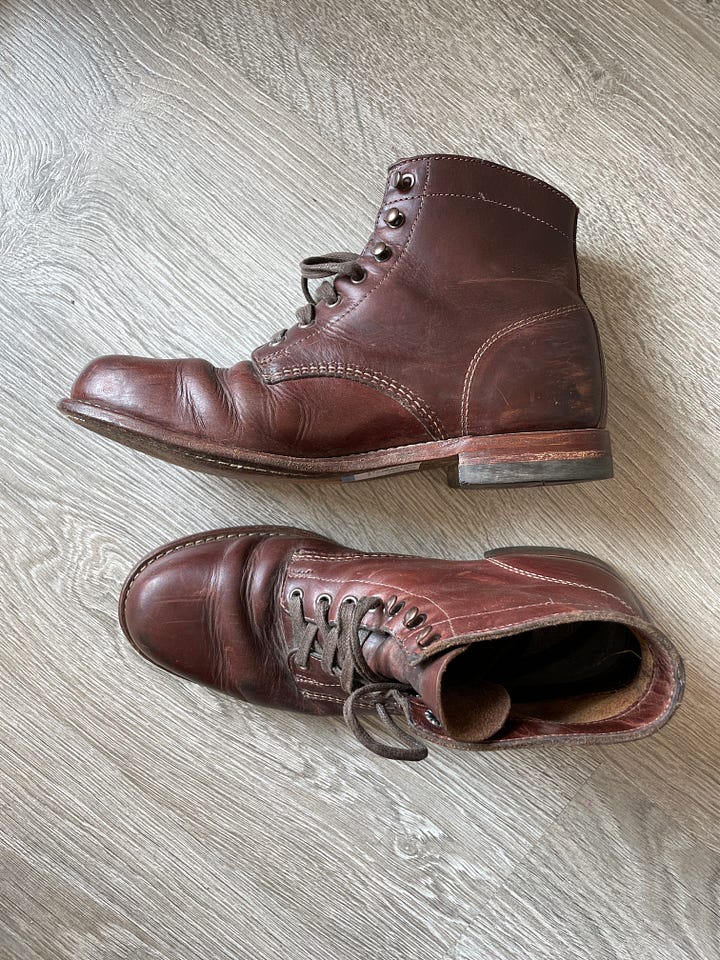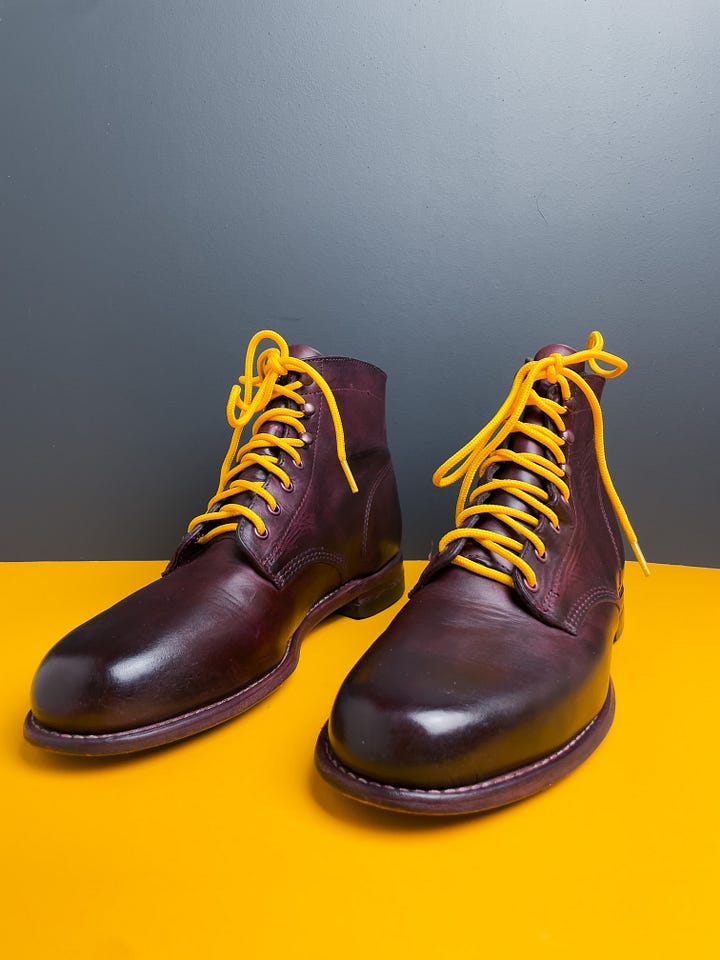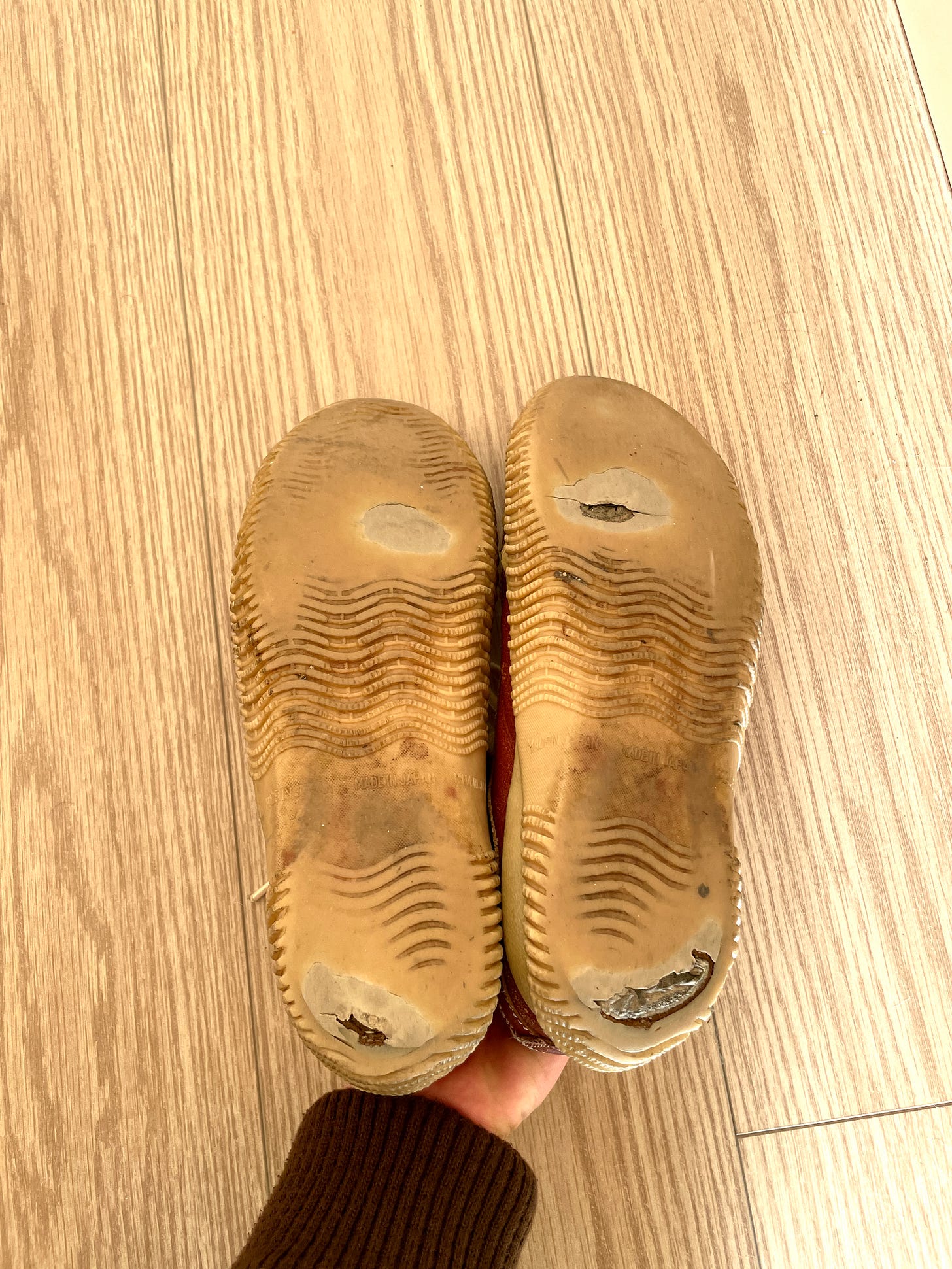01 - How to Choose Shoes for Urban Walking
Oh, the tricky balance of style, durability, and comfort (does it even exist?)
When I lived in Tokyo, I picked up a “problematic” habit: walking too much. I walked for hours around the city, and on several occasions made it all the way from Sumida to Shibuya on foot. That journey takes about 3 hours. Although I don’t walk that much anymore, my daily average hovers at around 14,000 steps.
I call walking problematic because it’s hard on your feet if you’ve got the wrong shoes, and I had many of those over the years. Besides, most shoes aren’t even designed for active urban walking. Deicing salts dry out the leather. The concrete is abrasive and literally melts away most soles.
Here are the soles of my favorite sneakers from Japanese brand Spingle Move after less than a year of walking daily:
If hikers and runners have special shoes, us urban walkers should have them too. Except urban mobility requires not only mere all-weather hardiness, but also puts a premium on comfort and elegance. It’s a tough balancing act.
Demanding better from urban footwear
If I were to write the three principles of urban footwear, it would be these:
Durability
You need footwear that will survive harsh concrete, deicing salts, and suspicious puddles made of rainwater, fuel runoff, and dog pee (being 100% real here guys).
This is where a welted construction with leather mid-soles and rubber outsoles shines. Premium full grain leathers, especially waxed roughout, can also increase durability.
Comfort
Comfort is a rather individual thing. But the constants are: arch support, comfortable lacing system that holds your foot in place, a cushioned footbed, and breathable materials.
Stylistic Flexibility
You’ll be wearing these pairs for 10+ hours a day. They have to work well with most clothes in your wardrobe. They must look good during the commute, at the office (unless you work from home ;)). They also have to look casual enough for a craft beer bar and sleek enough for a fancier cocktail place. Above all, they have to make you feel damn good about yourself.
That’s a lot to ask. Well, there’s an easy starting point: Goodyear welted leather shoes.
Durability and ease of repair: Go for Goodyear welted shoes
First, let’s get one thing out of the way. Goodyear welting is a classic type of shoe construction. It involves stitching the sole to a strip of leather (the welt), which is then attached to the upper. This creates a durable, water-resistant bond that’s easy to repair when the sole wears off.
You won’t see goodyear welted shoes in a typical sneaker store because this type of construction is more labor intensive (read: shoe manufacturers can’t make goodyear welted shoes in a developed country for $10 a pair).
While goodyear welted shoes come at a premium, their durability is out of this world.
I once picked up a pair of completely destroyed Wolverine 1000 Mile boots at a thrift store. After conditioning the upper and re-dyeing into a nice shade of Oxblood, I got them re-soled:


This is one of my most favorite pairs and I log thousands of steps in them each week.
Comfort: Pick the right last
A shoe last is the mold which shapes the shoe, and it determines its fit and feel: the width, toe shape, and arch support. Even when two shoes are the same size, differences in lasts can make one pair feel perfect while the other feels awkward and uncomfortable.
For example, I usually wear size 7 1/2 UK (8 1/2 US, 41.5 EU) in standard width. However, with some shoes I need to size up half a size to UK 8, or size down up to one size to UK 6 1/2. Some lasts are that roomy.
Thus, to ensure a good fit, you have to measure your feet. The ideal option is to use a Brannock Device [Wikipedia], which is purposely designed to capture the precise length, width, and arch length of your foot.

If you don’t have access to one, you can also use a tape measure to determine your foot’s length and width at its widest point. Knowing your those measurements will go a long way in helping you choose shoes that align with your foot shape.
Pro Tip:
When shopping for shoes, pay attention to the last used in their construction. Brands often list the last on their website or in product descriptions, and certain lasts are better suited for wide feet, high arches, or other specific needs.
A quick note about outsoles
There’s an overwhelming amount of outsoles on the market. Just the Vibram catalogue for 2024 runs at 190 pages, and there are more manufacturers out there: Cat’s Paw, JR, Lacta Hevea.
Know this: since you’ll be walking on hard concrete, the soles must be able to absorb the heel impact. Your knees will thank you.
Typically, three types of soles feature this characteristic: wedge soles, crepe soles, and natural rubber soles.
(I will probably write a separate post about them if I have the time.)
About Kōbō Mono
Kōbō Mono is a blog about quality boots and shoes.
It’s currently run by one person: me. (Talking about myself in a third person has never felt more odd.)
It’s a place to connect with the fellow footwear enthusiasts, share what I work on, and build a community.
If you like what you read here, please consider subscribing or sharing this post with friends. Your help will go a long way 🙏
And since we’re at it, I want you to know that my long-term dream is to start a shoe company. We’ll see how that goes.
You can read more in the About section here: https://kobomono.substack.com/about

